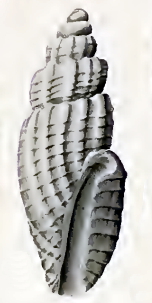Heterocithara rigorata facts for kids
Quick facts for kids Heterocithara rigorata |
|
|---|---|
 |
|
| Original image of a shell of Heterocithara rigorata | |
| Scientific classification | |
| Synonyms | |
|
Mangelia rigorata Hedley, 1909 (original combination) |
Heterocithara rigorata is a fascinating type of sea snail. These tiny creatures are marine snails, which means they belong to a group of mollusks that includes snails and slugs. This particular snail is part of the Mangeliidae family. It was first described by Charles Hedley in 1909.
Contents
About the Shell
Size and Shape
The shell of the Heterocithara rigorata is quite small. It usually grows to about 3.8 millimeters long. Its width, or diameter, is around 1.5 millimeters. Imagine a tiny grain of rice, and you'll get an idea of its size!
The shell is somewhat long and has a shape like a tower, which we call "turreted." It feels quite solid and is usually a dull white color.
Shell Features
The shell has six main sections, called whorls. The very first three whorls at the top are smooth and are called the protoconch. This is the part of the shell that formed when the snail was a tiny larva.
The shell has special patterns on its surface, known as sculpture. It features ten to twelve strong, raised lines that run up and down the shell. These are called "radial ribs." They are wider apart on the main body part of the shell and get closer together on the older, smaller whorls. These ribs stick out a bit at the top of each whorl and then slowly fade away towards the bottom.
Spiral Patterns
Around the main body whorl of the shell, there are about twelve to fourteen strong spiral lines, or "cords." These cords go over both the raised ribs and the spaces in between them. On the whorl just before the main body whorl, there are four such spiral cords. On the whorl before that, there are three. If you look very closely, you might even see tiny, fine lines running between and parallel to these spiral cords.
Opening and Variations
The opening of the shell, called the aperture, is quite narrow and long. It has a deep curve or notch, known as a "sinus." There is also a noticeable ridge, called a varix, near the opening.
Not all shells look exactly the same. Some Heterocithara rigorata shells might be a bit shorter and wider than others. However, this species is known for its straight, narrow shape, its tower-like spire (the pointed top part), and its very clear and strong patterns on the shell.
Where It Lives
This marine snail is found only in Australia. It lives off the coast of Queensland, which is a state in northeastern Australia. When a species is found only in one specific area, we say it is endemic to that place.

